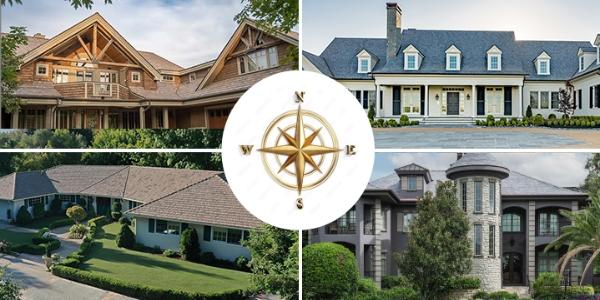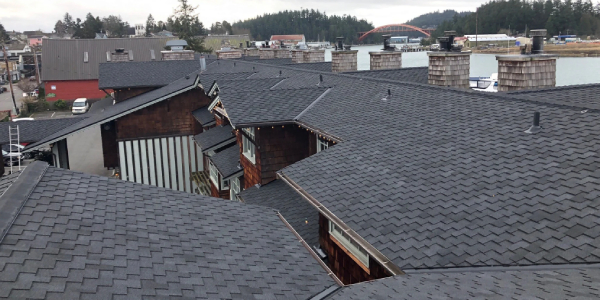How light affects exterior colors

By Kate Smith, DaVinci Roofscapes.
Homeowners may not realize that when making a color decision it's essential to consider how light affects exterior colors.
There’s much to consider when choosing an exterior color scheme, including roofing, doors and windows, paint colors and decorative accents. As a designer, it’s my job to make sure all these elements work beautifully together and that the home looks attractive at all times of day. Understanding the effect of lighting is a crucial consideration. Homeowners may not realize that when making a color decision it’s essential to consider how light affects exterior colors.
Let’s examine how the source, quality and direction of natural lighting can change a color’s intensity and bring out different undertones. Understanding how exterior colors appear in various lighting conditions will help you choose a color scheme that always looks beautiful.
Natural light on exterior colors
Natural light, or daylight, will vary according to the time of day, the season, and even the geographic location of your home. Daylight dramatically affects the appearance of exterior colors by highlighting surface textures and paint color undertones. Natural light also changes throughout the day depending on the position of the sun and the weather. Sunlight appears bright and clear in the morning and gray on overcast days. The golden hour, just before sunset, has a yellow cast that enriches warm colors and has a muting effect on cooler shades.
When choosing an exterior color scheme for your home, keep in mind that colors are affected by the following:
- The color qualities of light at different times of day
- The materials on the home’s facade
- The local climate and the number of sunny days per year
- The landscape around your home
- The direction your home is facing – north, south, east or west
When viewed from the street, a home’s orientation can make a big difference in a color’s undertones and intensity. If your home is in a wooded area, the shadows from surrounding trees can make colors look darker. It is critical to always look at actual color samples for items like paint, roofing and shutters, while outdoors.
North-facing homes
North-facing homes face the challenge of colors appearing more subdued because the natural lighting is less intense. If the front of your home faces north, you can expect exterior colors to feel slightly muted, grayed or darker than your sample.
- Warmer shades can help counteract this effect.
- Cool paint colors will appear grayer and may look dull.
- Blue or gray paint colors that have green undertones are a good choice.
East-facing homes
Morning light casts a warm glow, making colors appear softer and warmer. If your home faces east, it will receive soft morning light that is white and bright by midday. Exterior colors will be clear and consistent until mid-afternoon when the facade will be in shadow.
- Neutrals with warm undertones are less likely to turn dull under late day shadows.
- Cool paint colors will remain bright and clear under the midday sun.
- Bright morning light can make undertones more visible.
South-facing homes
South-facing homes receive strong and bright light throughout the afternoon. Southern light is warmer and appears golden yellow towards the end of the day. This yellow cast will affect almost every exterior color scheme.
- Warm exterior colors like yellow, green and brick red will appear more intense.
- Choose neutral paint colors with cool undertones.
- Color schemes that include cool gray or navy will help balance the warmer light.
West-facing homes
The light that comes from the West is rich and golden. If your home faces west, the facade will be in shadow until midday. In the afternoon, the house will bathe in intensely warm light. When selecting a color for a west-facing home, remember that exterior paint colors will take on a yellow cast.
- Neutral colors with cool undertones will balance the golden light.
- Cool gray and navy will be less affected by yellow tones.
- Warm colors like beige, yellow and green will appear more intense.
Consider the surface
When light falls on an exterior surface, the surface’s texture creates shadows that affect the color’s appearance. You may be surprised at how much darker or lighter a color looks on different surfaces. It’s important to bring home paint samples and test large swatches on the exterior of your home, so you can see the color and texture during different times of daylight.
To select the best color when painting rough exterior surfaces, keep these tips in mind:
- Shiny, smooth surfaces reflect the light, making paint on a smooth surface appear lighter.
- Rough textures like stucco and brick create thousands of tiny shadows between the surface’s highs and lows. These shadows make the paint color appear darker.
- When choosing materials with rough surfaces, if available, go a step lighter than the desired color.
- The same is true for dimly lit areas. The color you desire may need to be lighter than you think.
Evaluating exterior colors
Remember, all colors respond to light. When choosing colors, even neutrals, it is essential to know how they will look in the daylight that lands on your house. Now that you understand how your home’s location, surroundings, surface texture and lighting affect colors, you are ready to evaluate samples.
Here are a few last tips to ensure you have selected the best colors for your home exterior project.
- Look at samples on or alongside the house. When viewing each color, stand back about 15-20 feet.
- Be sure to look at the colors you are considering at different times to see how each appears as the natural light changes throughout the day.
- It is most critical to look at the colors on the front of the house. Still, since lighting shines on the house in differing amounts and from different directions, try the color on the back or sides, too.
- Taking time now, ensures you will make an excellent color decision you’ll enjoy for years.
There's lots more information on colors you can find on the DaVinci blog site. Please visit:
- Understanding Paint Color Undertone
- Your Home is Telling You the Best Colors to Use. Are You Listening?
- How to Choose Exterior Colors
Learn more about DaVinci Roofscapes here.
Have a question? AskARoofer.
Find your local roofing contractor in the RoofersCoffeeShop® Contractor Directory.










Comments
Leave a Reply
Have an account? Login to leave a comment!
Sign In